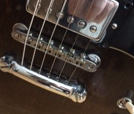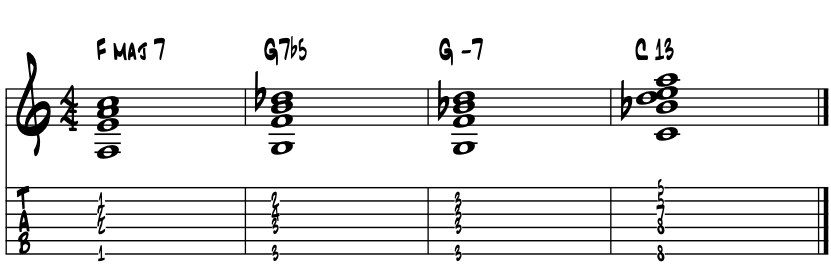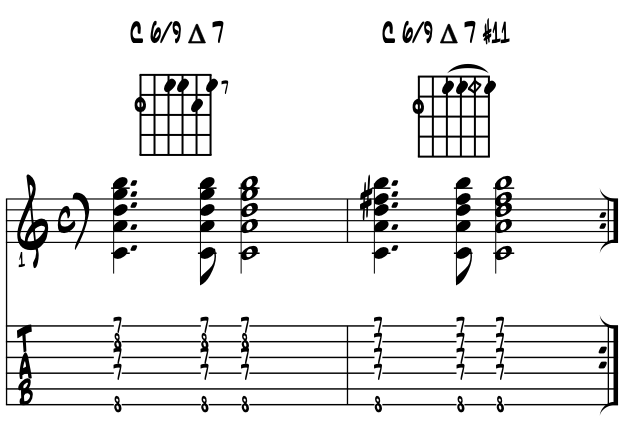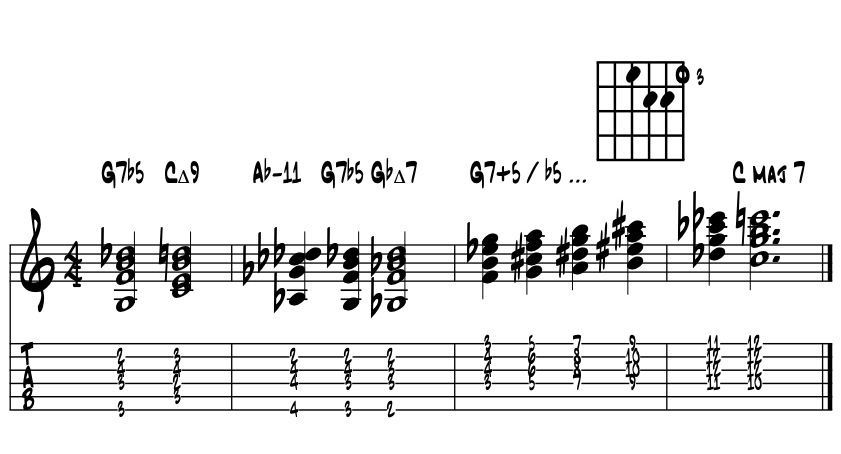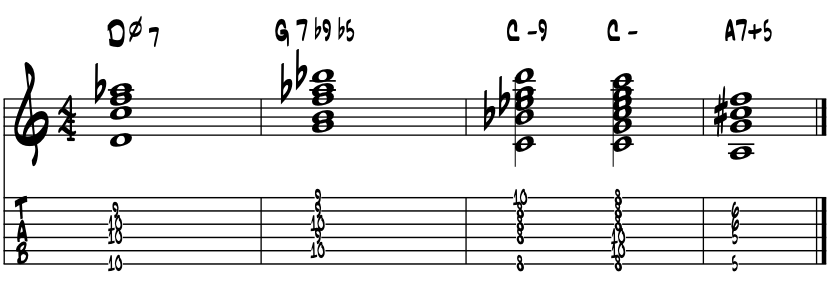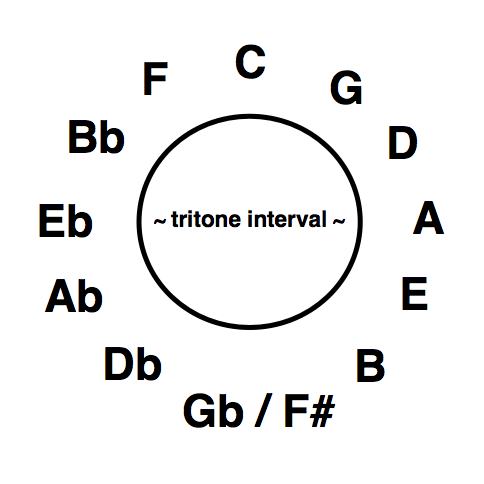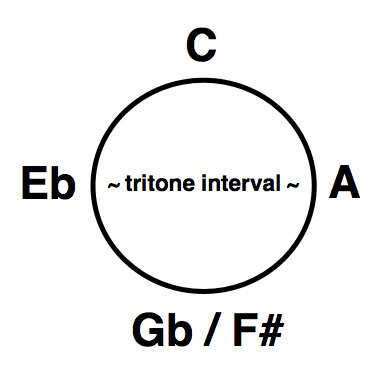~ the tritone ~ #iv ~ #XI ~
~ augmented (+) 4th / diminished (°) 5th ~ ~ and of course the tritone sub :)
|
In a nutshell. The enharmonic labeling of the #4 / b5 tritone interval provides us with the exact midpoint of our perfect octave span from either direction. ~ C C# D D# E F F# G G# A A# B C ~ As for the 'tri' in tritone, the 'tri' simply implies three whole tones while 'tone' equals a whole step interval. As diatonic Four, Five and the octave are perfect intervals, we use the terms to 'augment' up to #4 or 'diminish' down to b5, to find our half step away tritone from perfection. |
Melodically there's the blues hued lines created by the tritone / #4 within the blues scale. We'll get some whole tone magic too with 'b5' and work these up the octave becoming the #11 colortone. Kinda rare as a melody pitch in a diatonic melody lines, here's one with the #4 that might ring a bell. In 'C' major, drum roll please ... brrrrr ... example 1. |
 |
Who woulda' thunk huh? Mostly just pure diatonic triad notes and then the sharp Four / #4 creates the one of a kind melody, with a 'half step lead in' into Five. |
Harmonically, #4 / b5 tritone studies center around its catalyst role in V7 and the 'double tritone' of V7b9. This last ties us into Coltrane's evolution and ascension to Giant Steps, and towards today's 'chromatic blur', of the modernistas. Further forward on to #15 for a new system of composition etc. and we've reached a study apex. We've a similar theory and pitch paths for the aurally softened melodic minor / Lydian b7 way of grouping the pitches, softening from the fully diminished. Expanding basic changes into more jazzier chord substitutions associated with the 12 bar blues is another super exciting area to examine much of which is #4 / b5 generated, with knowing the basic theory here or even just the ability to spell chords by rote, opens up this vast blues sphere of chord substitutions, creating cycles of chords for creating lines 'through' the chord changes. |
The tritone in scales and chords. We theorists of the Americana magic should strive to understand and hear this essential spice in two core ways; as a single scale pitch within a group of pitches in a melody line, and a two pitch, tritone spanning interval, that lives in chords. |
Scale pitch. As a scale pitch, our tritone color is a super essential blue note. Initially we can find it added to the pitches of the minor pentatonic color. This simple edition of the one pitch tritone creates our core blues group of pitches. Examine the pitches of a 'C' blues scale. Ex. 1. |
|
 |
Nothing really too fancy in this last idea. Just pushing the buttons in order and the blues hue comes forth. In this last idea we follow right along the scale shape and pitches of our primary pattern with the 'x's marking the tritones. Have this one under your fingers? Do learn it here if need be. Example 1a.
|
This single scale shape is the original one that we inherit from from the earlier 'G open string banjo' tuning. |
A tritone melody. I think this next idea goes all the way back. Try it as a vamp behind the soloist. It's also a great start for horn players to head for the jungle. Example 2. |
Dig that big tritone vamp. Ought to be able to make that into some sort of 12 bar blues tune yes? |
Additional melodies. Bernstein's "Maria" beloved iconic Americana, features the tritone as it's second pitch. Deep jazz pianist Kenny Barron's "Voyage" has a very cool tritone lick at the close of the B section. As a passing tone in the A section, consequent phrase of composer Billy Strayhorn's "Take The A Train", is an essential jazz classic of course. And lots and lots of everyone's blues licks over the last century or so. |
|
Tritone focus. We also find tritone interval and pitch used way out in the open in the mix and at very loud volumes with giant distortion through stacks, as the focus point pitch in the melody line. Where ? We can find this in metal music and its subgenres, know of the 'Deep Purple's "Smoke On The Water" lick ? Tis is a tritone nuanced melody indeedee. |
|
Two pitch tritone in a chord. When built into chords as the 3rd and 7th, the presence of the diatonic two pitch tritone creates our dominant family of chords. This is the family of chords that directs our music, is the core of our cadential motions and the core harmonic color we use to back the blues. Do examine the pitch letter names locating the diatonic two pitch tritone from within the pitches of 'C' major, then run the changes of a few root position dominant chord shapes for guitar. Example 2a. |
|
 |
Recognize the evolution of these chords? Surely we can find the dominant / tritone color in all of the Americana styles we dig. This last sequence of chords evolves our 'G7' from folk / blues through rock, bossa and pop/ jazz and back to the bluesy V7#9 before resolving to the Hollywood tonic One chord. |
Tritone catalyst, in V7 it's the 3rd and 7th. Any dominant 7th chord, used in any and all of our musical styles or situations, has a tritone interval in it. Usually along with a root and 5th, it makes Five seven V7 :) Please examine letter name, notation and sound of the diatonic pitches of 'G7', the dominant V7 chord in the key of 'C' major. Example 3. |
|
Tritone resolution / leading tone up and 4-3 down. The resolution of the tritone interval pitches in the Five to One cadential motion is based on key two aspects. First is that our pitch 'B' is the leading tone to 'C.' Second, that 'F' resolves down by half step to E, the major 3rd of our 'C' chord. So we follow the age old voice leading idea; that if we move each of our pitches of one chord to the closest pitches available of the next chord, chances are we'll be groovy in sound and theory. |
So just like our physical gravity, proximity of pitch creates a tonal pull or gravity, i.e., the leading tone resolves by ascending by half step, 'B to C.' Thus, our B to F tritone interval within G 7, following the 'closest rule', resolves to C major in the following manner. What goes up must come down. Example 3a. |
Tension / resolution. Sense the tension / release dynamic in the pitches? Yes ? Cool. After hearing the music a few times, can you predict what'll happen next? Developing a sense of this aural predictability becomes a key aspect of our artistic evolution and a way to understand the components that are commonly found in each of our main musical styles. |
No? Not sensing the tension / release dynamic? Then ya might want to just stop right here until you do. Get out your guitar and jam along. Just keep clicking to hear the sound of the above resolutions, find the pitches and chords and stretch the time to create additional tension. This basic artistic dynamic, tension and its release, is sort of a big deal as it lives nearly everywhere to some degree in our Americana music. |
Update our DNA. 'Feeling' this release of the G7' chord's tritone tension, upon the sounding of the tonic 'C' major chord, is surely one of the keys to better understanding the theory of our local Americana musical universe. This Five 7 to One cadential motion is simply everywhere in our American music and has been for the last couple of hundred years. So if need be, do take the time to get it in your DNA here and now, and then you'll know you'll be good to go, for evermore :) |
What about the flip side? In this tritone pitch pairing of the pitches 'B and F', can we make 'F' the leading tone? Absolutely. And 'F' is the leading tone pitch to what key center? Please examine the pitches of the two possible resolutions for the pitches 'B' and 'F.' Do note the enharmonic spelling shift of the 'B / Cb' when 'F' is the leading tone. Example 3b. |
|
|||||||||||||||||||||||||
Here we've simply reversed the direction of the resolutions of the 'B (Cb)' and F pitches. F becomes the leading tone and resolves upward, as all leading tones tend to do, while now the 'B (Cb)' goes down, again as a 4-3 suspension. Same process just flipped a bit. Please examine the pitches. Example 3c. |
 |
Ever been to 'Gb' major? It's the other side of the universe from where we normally hang out, especially as guitar and bass players. That we can change which pitch of our tritone interval is the leading tone and in doing so consequently change the direction of the resolution? Yes indeed. Of course the different leading tones take us to different key centers. So if it's the same tritone, can we swap these chords around? |
Tritone substitution / motion by 1/2 step / the half step lead in. A most common chord substitution in American blues and jazz is working with V7 and its tritone substitution potentials. If your thing doesn't really swing yet there might be a reason, and this theory just might be the newly found key to unlock swing for you. In this next idea we expand the Five / One cadential motion by including a diatonic Two chord. Please examine the following Two / Five / One motions into 'C' major. Example 3d. |
C major diatonic chords |
tritone substitute |
 |
|
ii / V / I |
ii / b II / I |
 |
|
We're going to 'Gb' major. Same ideas as above but simply going to the other key center as provided by the tritone / leading tone theory examined above. The following voicings are solid core jazz guitar shapes. Please examine the following Two / Five One motions into 'Gb' major. Example 3e. |
|
Gb major diatonic chords |
tritone substitute |
 |
|
ii / V / I |
ii / b II / I |
 |
|
Rather sweet n'est-ce pas? Notice how much sleeker the tritone cadential motions are due to their chromatic bass lines? In our Americana music, sleekness is one sure way to encourage acceleration. Of what? Well two things that Americana jazz players love to do. Play in brighter tempos and change keys more often. |
The rule of thumb for tritone subs. In theory, and when starting out, we should substitute dominant chords with dominant chords. For in this chord type the tension / resolution is organic and we've had it all along. |
And that's all there is to it. At least in terms of the initial theory of the thing. So we can change which pitch of our tritone interval is the leading tone and thus change the direction of the resolution? Yes indeed. Of course the different leading tones take us to different key centers, both relatives of the diatonic. This expands of course with 'double tritone' of V7b9. |
Where in the music. Dig the sounds of the above cadential possibilities? Do realize we are starting to move out of the diatonic realm of most things Americana music. While this sort of substitution is very common in jazz, it's rather rare anywhere else. Hen's teeth rare ...? Yes pretty much. |
We just do not find tritone substitute chords in folk, rock, pop or their myriad genres. Even the blues? Yes, for the most part even the blues, unless we call the 'half step lead in' motion a tritone sub. Of course the blues plays a giant role in jazz so this bridge is already there. And while at the core a jazz blues and a delta blues have identical elements, in practice they become two distinctly different animals, each capable of their own unique doings yet share the same DNA. Like us ? Yep, just like us. Same basic DNA, everyone is unique :) |
Evolving our thought process. A core philosophy of this "Essentials" work is based on the idea that an artist will consciously choose to create greater challenges as they mature in their work. Being a student of jazz music, I know this to be the norm. Each of our musical styles has its own unique challenges that the pro players strive to master. Know that the theory is all one and the same. |
The next level. So how does an artist create the next level of challenge for themselves artistically? In theory we can simply expand our number pitches one by one. For example; V7 to V9, ii-7 to ii-9 etc., adding a pitch to make Four into Two, or add b9 to V7. We can warm up on a pentatonic folk melody and gradually add new pitches towards including all 12. See where these new colors take us artistically. Change to a higher number on your time generator. |
Using the theory to evolve. As in the above tritone sub discussions, we used the theory to evolve a new chord progression. Of course, originally someone 'discovered' this process, and we theorists came along after and figured out their coolness. So our theoretical evolution encourages our artistic evolution. Which was initially prompted by someone's artistic evolution or discovery. So hand and hand and round and round it goes. With this organic evolutionary process in mind, the following philosophy of this text emerges; the double tritone. With a 'double tritone' interval in a chord, we gain an artistic license to move its pitches in symmetrical patterns up and down the fingerboard, creating musical ideas that can enhance, often very dramatically, our directive cadential motions and resolutions. There's two motions associated with these double tritone harmonies; by whole step for augmented and minor 3rd for diminished. Symmetry of motion also provides for possible additional stops along the way to our destinations, branches off the main path, but possibilities to explore none the less. Symmetrical motion in the harmony, from the early 1960's onward, expanded our existing palettes in wonderful ways. And with this powerful motion, our melodies then re-exploded into new expression of style, often based on the five note, pentatonic colors. |
|
A double tritone / V7b5 chords. There is common way we can bring a double tritone to the lower part of our dominant harmony. In this new color we retain the major 3 and blue 7, which together create the essential core tritone of V7. To this we can add a second tritone by simply lowering the 5th of the chord by half step. This creates a tritone interval between our root pitch and our lowered or diminished 5th (#4), opening up to the 'by whole tone' universe of motions. Please examine the pitches and their sound. Example 5. |
arpeggio degrees |
1 |
3 |
b5 |
7 |
. |
. |
. |
. |
G 7b5 pitches |
G |
B |
Db |
F |
. |
. |
. |
. |
whole tones |
G |
A |
B |
Db |
. |
. |
. |
. |
Surely not an everyday color, these V7b5 chords find their way into rather select spots. As a jazz artist, the whole tone colors are right at hand. |
So where in the music? Bossa nova artists dig this chord V7b5. The last example is similar to Jobim's "Desafinado." As a Five of Five, any alteration is within bounds. Jazz players find all sorts of places for this color. It is also used as a penultimate chord, or even final hold in arrangements, for a splash of dissonance, especially in the blues leaning songs. |
|
In more modern playing today, players will also use the lowered 5th on their tonic major 7th chord type, further reducing the center of tonal gravity of their tonic function chords. Jazz pianist Bill Evans is thought to have been quite fond of this color. |
|
A double tritone / V7b9 chords. Our second quite common jazzy dominant chord with a double tritone occurs in the V7b9 chord. While it is a bit outside of this realm #4 / b5 realm, these two chords, 'b5 and b9', as dominant V7 types will function pretty much the same ways. That both are very cool setting up minor tonic chords and key centers as well as major shows their flexibility for either context. V7b9 is unique in that it has the perfect minor 3rd symmetry of a fully diminished 7th chord in its DNA. This symmetry of leading tones opens up the entire Americana harmony for its evolutions towards the chromatical 12 tone sounds of the 'tres modernes' (my term) from the late 1950's and forward till this day. As V7b9 portals us to a whole 'nother universe to explore, click the link to go on over. For it's back to #4 / b5 for the rest of this discussion. Back on task ? Yep. |
|
Up an octave to #11. In thinking of our numerical designations that #4 can = b5, which of course it does, we can simply expand this root / tritone pairing by moving the #4 / b5 up one octave in the arpeggio to #11, and find other coolness in between. Please examine the pitches in 'C' major. Example 5a. |
scale degrees |
1 |
2 |
3 |
#4 |
5 |
6 |
7 |
8 |
C major |
C |
D |
E |
F# |
G |
A |
B |
C |
arpeggio degrees |
1 |
3 |
5 |
7 |
9 |
#11 |
13 |
15 |
pitches |
C |
E |
G |
B |
D |
F# |
A |
C |
Cool ? Creating an arpeggio from a scale is an essential theory skill. Learn it here if need be; scale, arpeggio, chord. This next idea features the back and forth between the 5th of the chord to the #11, designated by the triangle in the #11 chord grid. Example 5a. |
Modern Latin vamp. This last idea is fairly common these days among jazz players looking for extended solo sections, with an almost static or non changing harmony. The voicing above, a true Doc Miller Hollywood chord, easily phases back and forth with the tonic major 7th and the #11 / Lydian based color. If we're skilled enough to make the bar lines go away in the Latin groove, this type of extended soloing just might go on for a couple of days while all dancers rejoice rejoice rejoice :) |
Whole tone qualities. Well anytime we get three consecutive whole steps we gain the whole tone color potential. The wholetone grouping of pitches holds the same symmetrical properties as the diminished color. It has the 'multiple resolution to assigned tonics' from one set group of pitches commonly arranged as a whole tone scale, arpeggio or chord. And like the diminished shapes, whole tone can be moved as a constant structure, now by the intervals of a whole step, the two whole step major third, three whole step tritone etc., all the while retaining similar core pitches and the overall tonal direction of the composition. |
Whole tone resolving qualities. In examining our whole tone, double tritone V7b5 chord, 'root to b5/maj 3 to b7', we can easily fill in the rest of the pitches generated by the whole tone scale formula and create the complete whole tone scale. From this we can diatonically build our altered dominant chords and see the possible resolutions based on our Five / One cadential motion. Example 6. |
scale degrees |
1 |
2 |
3 |
#4 / b5 |
#5 |
b7 |
8 |
G whole tone scale |
G |
A |
B |
C# / Db |
Eb |
F |
G |
arpeggio degrees |
1 |
3 |
5 |
7 |
. |
. |
. |
G 7b5 pitches |
G |
B |
Db |
F |
. |
. |
. |
V7b5 chords |
G7b5 |
A7b5 |
B7b5 |
Db7b5 |
Eb7b5 |
F7b5 |
. |
V7b5 chord pitches |
G B Db F |
A C# Eb G |
B D# F A |
Db F G B |
Eb G A Db |
F A B Eb |
. |
resolution maj / min |
C / A- |
D / B- |
E / G#- |
Gb / Eb- |
Ab / F- |
Bb / D- |
. |
Common V7b5 motions. In this next idea we put some of the above color to work with resolutions to major tonic One chords. Example 6a. |
To the minor key center. The b5 dominant color into the minor tonality can get pretty tangled up as the b5 can be a half step above our tonic / root pitch. Note in the next idea that we briefly move up to the b9 before resolving to 'C' minor. Of the augmented / whole tone colors, the V7+5 (#5) is possibly more common into the minor tonality as the +5 is the blue 3rd of our tonic. Here's a four bar loop in 'C' minor. Example 6b. |
Whole tone chord resolving magic. Turns out that from the same group of pitches we'll get the V7+5 chords also. This augmented dominant color is a bit more common, especially into the minor key centers. Please examine the pitches with a careful eye towards enharmonic pitches as the chords are spelt. Same set of resolution key centers. Example 6c. |
scale degrees |
1 |
2 |
3 |
#4 / b5 |
#5 |
b7 |
G whole tone scale |
G |
A |
B |
C# / Db |
Eb |
F |
arpeggio degrees |
1 |
3 |
5 |
7 |
. |
. |
G 7#5 pitches |
G |
B |
Db |
F |
. |
. |
V7#5 chords |
G7#5 |
A7#5 |
B7#5 |
Db7#5 |
Eb7#5 |
F7#5 |
V7#5 chord pitches |
G B Eb F |
A C# E# G |
B D# G A |
Db F A# B |
Eb G B Db |
F A C# Eb |
resolution maj / min |
C / A- |
D / B- |
E / G#- |
Gb / Eb- |
Ab / F- |
Bb / D- |
A key diminished chord built on sharp Four. This penultimate entry in covering our sharp Four position within the local chromatic universe is a rather common event in the blues, especially when jazz players get a hold of the 12 bar form. Turns out in the 6th bar the harmony begs to go to the #iv dim 7 chord. Really? Yep, very common with jazz players. Just yet another way to accelerate the sense of forward motion while getting a wee bit more mileage out of the thing and another chunk of harmony to shape our melodic line. Here are the basic changes, thinking 'C' Blues. Example 7. |
Catch that diminished color on #4 ? Just another way to jazz up a basic 12 bar blues. |
Taking it out. This last idea for sharp Four is quite common in certain circles, it's one of the 'arrangements while you wait' type endings that players often will improvise together. It's cool in that we use the tonic pitch as a common tone to link all of the chords together in progression as we take it out. Thinking here F major, we simply harmonize a chromatic, descending bassline from sharp Four to One. Example 8. |
All kinds of ways to jazz this last idea up, or leave it as it is and let the drummer work the magic :) |
"The drummer; he inspired me to play like no one else I have ever met. |
Coda / wheel of tritones / cycle of fifths. The tritone interval enjoys a rather distinctive status on our wheel of pitches. It's curious how this all shakes loose but it is what it is. Please examine the location of our tritone intervals on our 12 pitch keyclock. Example 9. |
|
|
||||||||||||||||||||||||||||||||||||
Really? Directly across the clock face? We can locate any pitch's tritone interval by locating the pitch directly across the circle? That is indeed the case mon ami. Crazy huh but very handy :) So knowing this, check this out. Example 9b. |
|
WOW ! Now the compass points show us four key centers, each of which is the major / relative minor tonic of each other. I'll have to add this into the mix. This visualization of the major / minor key centers from within the cycle of fifth's is new for me. I just discovered this :) Maybe print and tack these two up for reference. |
First review; so where's the tritone in our music? Well anytime we're grooving on anything with a hint of the blues, chances are there's a tritone in the local neighborhood; in both melodies and chords. So in thinking of the Americana sounds, in a word, everywhere. Well, probably not in children's songs of course, unless they're very spooky Halloween tunes. |
In folk, never ( did I just say that ... yet another first :) in the melody but always of course in any standard type of V7 / 'G7' / 'D7' chord etc. The blues influence in any of the folk or rock styles of course needs the tritone pitch for chords and though very rare, in melody intervals. |
The metalists love the tritone interval. It's kind of all over their music and used to very cool dramatic effect. In pop, again any V7 chord is going to have the tritone within. Rare in pop melodies, although one of America's favorite melodies from 1957 "Maria", is classic tritone featured line, a 'b5 to 5 sus on up.' |
|
For jazz and beyond, and like everything else, we jazz theorists can conjure. The tritone is a super catalyst for coolness, a building block to new horizons where it often loses its bristly edge and becomes a key step in the stairway to the musical stars and beyond. |
Where in history. Well, early Western Euro history was not overly kind to our tritone. Known at one point as the 'diablo de musica', big tritone players probably have had a bit of a rough going all along. Yet once the Americana blues took hold, its clarion call of attention to our commonly shared human sensibilities has shook the globe over and over, as the blues hue is somewhere in most every style imaginable. And still does. For as a cherished member of the melting pot of our Americana music family, even when more quietly encapsulated within V7, the tritone energies are always there. |
|
Expansive thoughts. When the jazz harmony started to evolve in the later 30's toward bebop with help from guitarist Charlie Christian, the double tritone fully diminished 7th chord color found a way into what was then known as a "Sears Roebuck Bridge." This organic 'double tritone' opened up a new way to look at things. As artists got hipper, through what becomes V7b9 theory, they created a new, totally inside and legit way 'out' with the same old pitches. Within twenty five years or so of Mr. Christian and his contemporaries adventurous work, John Coltrane shedded, wrote and released "Giant Steps", a landmark composition which even today sits as the crown jewel atop the new theory / shedding challenges that guitarist Mr. Christian helped initiate, which Mr. Coltrane then developed, conquered and evolved. |
|
Second review. Perhaps needless to say the tritone has come quite a ways since its days as "el diablo." A core component in Americana blues from earliest times, the root of all things Americana music, the tritone and its related activities plays an essential role in anything blues influenced and beyond. |
Our tritone comes in two basic varieties. As a single note interval measured from another pitch, or as a two pitch pre-made tritone interval, that we slip into existing structures. Our single pitch, octave splitter is the crucial pitch to evolve the blues scale from its five pitch minor pentatonic core. While adding in the two pitch tritone evolves the major pentatonic group of pitches into the seven pitch diatonic major / relative minor scales. |
In our harmony, the tritone color creates the basis of aural tension that makes our dominant Five seven chord a dominant V7 chord. We'll find this basic chord generally within all of our American musical styles. From V7 forward, at least within the jazz language, artists have added the tritone's symmetrical theory properties to find new ways to create the tension and release of their art. |
"I’m not accustomed to talking about myself, I talk in the studio with musicians. Or through my songs." |
wiki ~ Allen Toussant http://www.nytimes.com; 11/11/15 |
References. References for this page's information comes from school, books and the bandstand and made way easier by the folks along the way. |
Find a mentor / e-book / academia Alaska. Always good to have a mentor when learning about things new to us. And with music and its magics, nice to have a friend or two ask questions and collaborate with. Seek and ye shall find. Local high schools, libraries, friends and family, musicians in your home town ... just ask around, someone will know someone who knows someone about music and can help you with your studies in the musical arts. |
|
Always keep in mind that all along life's journey there will be folks to help us and also folks we can help ... for we are not in this endeavor alone :) The now ancient natural truth is that we each are responsible for our own education. Positive answer this always 'to live by' question; 'who is responsible for your education ... ? |
Intensive tutoring. Luckily for musical artists like us, the learning dip of the 'covid years' can vanish quickly with intensive tutoring. For all disciplines; including all the sciences and the 'hands on' trade schools, that with tutoring, learning blossoms to 'catch us up.' In music ? The 'theory' of making musical art is built with just the 12 unique pitches, so easy to master with mentorship. And in 'practice ?' Luckily old school, the foundation that 'all responsibility for self betterment is ours alone.' Which in music, and same for all the arts, means to do what we really love to do ... to make music :) |
 |
"These books, and your capacity to understand them, are just the same in all places. Always bear in mind that your own resolution to succeed, is more important than any other one thing." |
|
Academia references of Alaska. And when you need university level answers to your questions and musings, and especially if you are considering a career in music and looking to continue your formal studies, begin to e-reach out to the Alaska University Music Campus communities and begin a dialogue with some of Alaska's finest resident maestros ! |
|
~ |






